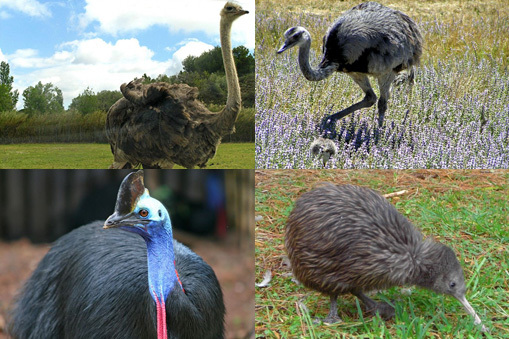A DNA study of extinct elephant bird specimens held at Wellington’s Museum of New Zealand Te Papa Tongarewa have revealed the birds to be the kiwi’s closest relative – overturning thinking that the kiwi’s nearest relatives were the Australian emu and cassowary. It addition, it suggests a new evolutionary pathway for the family of ratites.
Adult elephant birds, which once colonised the island of Madagascar, were over 2 metres tall and weighed in at around 250 kilograms. Like kiwi, and other flightless birds such as the African ostrich, the Australian emu, the South American rhea and tinamous and the extinct moa, the birds are members of the ratite family.
It has long been thought that the birds had a common flightless ancestor, which spread from continent to continent on foot prior to the break-up of the supercontinent Gondwana over the last 130 million years. However, this theory is in question after the team of Australian and New Zealand scientists from the Australian Centre for Ancient DNA, Flinders University and New Zealand’s Landcare Research examined the genetic evolution of ratites (their phylogeny), adding in ancient mitochondrial DNA sequences from the elephant bird to that already collected from moa bones and other living species of ratites.
The researchers write in their published paper that the “early isolation of Africa and Madagascar implies that the ostrich and extinct Madagascan elephant birds (Aepyornithidae) should be the oldest ratite lineages”. However, the elephant birds’ phylogenetic analyses showed that “these birds are the closest relatives of the New Zealand kiwi and are distant from the basal ratite lineage of ostriches” – despite the differences in geography, morphology and ecology between the two species.
In other apparent mismatches, they also found that the small South American tinamous are a close relative of New Zealand’s giant extinct moa.
This unexpected result contradicts the idea of continental spread and then subsequent geographical isolation by continental drift and instead supports a different theory that ratites evolved from flighted ancestors who then developed large sizes and loss of flight independently in different lineages only after flying to their new homes. “We suggest that convergence toward gigantism and flightlessness was facilitated by early Tertiary expansion into the diurnal herbivory niche after the extinction of the dinosaurs.”
Around 50 million years ago, this window of opportunity to grow big, opened by dinosaur extinction, began to close as mammals developed to compete for the available grazing. It is thought that perhaps the kiwi missed out on becoming big in New Zealand, as its ancestors arrived here after giant moa were already occupying the niche.
The work overturns previous research conducted in the 1990s by Professor Alan Cooper, who was the lead researcher on this latest project. Unperturbed by the unexpected finding, Professor Cooper joked in a press conference,
It’s great to finally set the record straight, as New Zealanders were shocked and dismayed to find that the national bird appeared to be an Australian immigrant. I can only apologise it has taken so long!
The research was published in the 23 May 2014 edition of the journal Science.
Related content
New genetic research in 2023 has shed new light on another iconic species – the takahē. It has not only uncovered the significant impact of humans and past climate change on the takahē but has also led to new theories on their evolutionary history.
Useful links
Find out more about Madagascar’s extinct elephant bird on the BBC website here.

